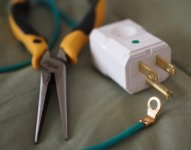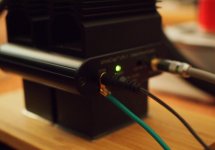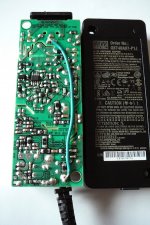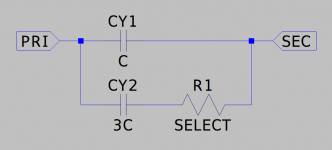Hi Soundcheck ,
On a class 2 (unearthed SMPS) you need Y caps between input/output of transformer for EMC reasons. You are connecting DC side to Live/Neutral of AC line . This will allow leakage current to be present on your output . Since there is no earth , this leakage current will flow into your powered device.
So yes its considered isolated , but its not a good solution since you traded the wolf for a lion . This lion is stealthy and unpredictable . Nothing to hunt him and change it into a cat (like RC filters , LC , CMC. LDOs)
Batteries are a good option but impractical for most people
Earthed SMPSs provide a path of leakage current to return to earth . In my opinion this is good option.
LPSs have some stray capacitance between input/output but much less than Y caps and as such they are always a good choice when implemented properly .
On a class 2 (unearthed SMPS) you need Y caps between input/output of transformer for EMC reasons. You are connecting DC side to Live/Neutral of AC line . This will allow leakage current to be present on your output . Since there is no earth , this leakage current will flow into your powered device.
So yes its considered isolated , but its not a good solution since you traded the wolf for a lion . This lion is stealthy and unpredictable . Nothing to hunt him and change it into a cat (like RC filters , LC , CMC. LDOs)
Batteries are a good option but impractical for most people
Earthed SMPSs provide a path of leakage current to return to earth . In my opinion this is good option.
LPSs have some stray capacitance between input/output but much less than Y caps and as such they are always a good choice when implemented properly .
Power amp should be earthed , I would use SMPS with earthed AC input (casing earthed and L/N going to PE through Y caps) on both RPI and DAC . Depending on your particular setup (line impedance /potential differences), I would try earthing the DC output on the RPI power first and then on DAC
I don't think there is one answer that fits all.
I don't think there is one answer that fits all.
The best commercial solution ever offered for grounding audio systems is no longer in production, but they work very well and employ a very clever design. They are still available from time to time on ebay, but even used not all that cheap. I know the designers and some of the users, and can attest that the things work quite well. They are Monster HTPS 7000 MKII (only that exact model). https://www.ebay.com/sch/i.html?_from=R40&_trksid=m570.l1313&_nkw=Monster+HTPS+7000+MKII&_sacat=0
EDIT: Lacking something like the Monster power conditioner, balanced interconnects can be used everywhere, or if RCA unbalanced connectors are the only choice then use really good ones (not fancy looking ones) and use RF cable with a very low impedance shields. The idea is to make there only one preferred path for LF audio signal ground return currents to flow, and they always split up to follow the path of least resistance.
EDIT: Lacking something like the Monster power conditioner, balanced interconnects can be used everywhere, or if RCA unbalanced connectors are the only choice then use really good ones (not fancy looking ones) and use RF cable with a very low impedance shields. The idea is to make there only one preferred path for LF audio signal ground return currents to flow, and they always split up to follow the path of least resistance.
Last edited:
Hmmh. Not sure if I can follow here.
What you say.
In case I'd use your super clean supplies for powering
1. Pi
2. DAC-HAT
with its two outputs.
I should run another mains earth wire to the RPI GPIO "-" pin!?!?
I think he means ground the SMPS's DC output to shunt AC leakage current to GND.
You can easily DIY that kind of cable with various parts, or for $49 there is the iFi Groundhog. The picture below is not an RPi, but the same idea, that's the DC output of a Mean Well SMPS grounded back to the AC safety GND.
Attachments
Last edited:
That doesn't make much sense to me.
I've seen these proposals to get rid of the "iFi iPower noise".
I always asked myself, if it is really the iPower they are addressing.
Or is it a groundloop over e.g. a non isolated amp that's been shunted.
I wondered if these guys ever reviewed their overall grounding scheme.
I've seen these proposals to get rid of the "iFi iPower noise".
I always asked myself, if it is really the iPower they are addressing.
Or is it a groundloop over e.g. a non isolated amp that's been shunted.
I wondered if these guys ever reviewed their overall grounding scheme.
That doesn't make much sense to me.
I've seen these proposals to get rid of the "iFi iPower noise".
I always asked myself, if it is really the iPower they are addressing.
Or is it a groundloop over e.g. a non isolated amp that's been shunted.
I wondered if these guys ever reviewed their overall grounding scheme.
Give it a try it anyway, I've found it to make a not so small improvement, even when the SMPS is just energizing the UpTone LPS-1 UltraCap supply. There's no ground loop issue there, only AC leakage current.
I'm sure everyone should be reviewing their overall grounding scheme, and yes I agree that there are probably too many instances where ground loops are occurring.
However that doesn't invalidate this approach, you should try it, it's not in any way limited to the iPower, it's cheap and easy to do, and as cdsgames said "I don't think there is one answer that fits all", he's right and trying this may just provide you with a pleasant surprise.
Some people do the Mean Well like this:
Attachments
Last edited:
Hi Soundcheck ,
On a class 2 (unearthed SMPS) you need Y caps between input/output of transformer for EMC reasons. You are connecting DC side to Live/Neutral of AC line . This will allow leakage current to be present on your output . Since there is no earth , this leakage current will flow into your powered device.
So yes its considered isolated , but its not a good solution since you traded the wolf for a lion . This lion is stealthy and unpredictable . Nothing to hunt him and change it into a cat (like RC filters , LC , CMC. LDOs)
Batteries are a good option but impractical for most people
Earthed SMPSs provide a path of leakage current to return to earth . In my opinion this is good option.
LPSs have some stray capacitance between input/output but much less than Y caps and as such they are always a good choice when implemented properly .
If it is of any help I seem to recall that the primary to secondary capacitors are not strictly or solely there for EMC purposes.
In the case where you are performing secondary side regulation by feeding back over the isolation boundary in order to control the primary side PWM you can experience common mode noise problems with the feedback loop.
Such behaviour is tamed by including those Class Y capacitors across the boundary. You may also notice that some circuits include additional parallel RC networks which look like pic.
These are in place to damp or otherwise tame parasitic resonances. Your wolf/lion might still become a cat and there is the possibility for DIY folks to do a 'select on test' to discover the optimal value for the resistor.
Attachments
...that doesn't invalidate this approach ...
I never said that...
I do think many of the tweaks being figured out by the DIY crowd, by applying trial-and-error tactics, make it back into the design processes of this or that manufacturer. Or at least manufacturers realize potential flaws in their designs or thinking. I think Allo can confirm that.
Guess why iFi wrote that IMO nice iPower document? They realized being under fire. And they also felt to explain how to achieve these promised performance levels.
Nowadays I'm more interested in the "WHY", to tackle the root-cause and not the symptom by adding another workaround. Fighting the symptoms, without knowing what you're doing, leads to piling up stuff like LPS-1 or whatever next great things are popping up...
...my basement is full of these DIY-audio skeletons.
If it is of any help I seem to recall that the primary to secondary capacitors are not strictly or solely there for EMC purposes.
In the case where you are performing secondary side regulation by feeding back over the isolation boundary in order to control the primary side PWM you can experience common mode noise problems with the feedback loop.
Such behaviour is tamed by including those Class Y capacitors across the boundary. You may also notice that some circuits include additional parallel RC networks which look like pic.
These are in place to damp or otherwise tame parasitic resonances. Your wolf/lion might still become a cat and there is the possibility for DIY folks to do a 'select on test' to discover the optimal value for the resistor.
mmmm that looks like a very interesting idea. I will test it.
That doesn't make much sense to me.
I've seen these proposals to get rid of the "iFi iPower noise".
I always asked myself, if it is really the iPower they are addressing.
Or is it a groundloop over e.g. a non isolated amp that's been shunted.
I wondered if these guys ever reviewed their overall grounding scheme.
Earthing of GND of IFI output works (reduces noise on 5V GND)
I never said that...
I do think many of the tweaks being figured out by the DIY crowd, by applying trial-and-error tactics, make it back into the design processes of this or that manufacturer. Or at least manufacturers realize potential flaws in their designs or thinking. I think Allo can confirm that.
Guess why iFi wrote that IMO nice iPower document? They realized being under fire. And they also felt to explain how to achieve these promised performance levels.
Nowadays I'm more interested in the "WHY", to tackle the root-cause and not the symptom by adding another workaround. Fighting the symptoms, without knowing what you're doing, leads to piling up stuff like LPS-1 or whatever next great things are popping up...
...my basement is full of these DIY-audio skeletons.
In case of IFI the "why" is very clear. Unearthed SMPS have leakage current thats appears because of Y caps. It has no place to go..except to devices they power. Its not a IFI flaw , its has to do with the fact that psu is not earthed.
Hmmh. Not sure if I can follow here.
What you say.
In case I'd use your super clean supplies for powering
1. Pi
2. DAC-HAT
with its two outputs.
I should run another mains earth wire to the RPI GPIO "-" pin!?!?
I wont refer to our PSUs as per the spirit of the diyforums. I can refer to any earthed smps. By connecting your GND (5V) to earth you are providing a path for leakage current to flow.
Unfortunately one answer does not fit all. By having multiple earth points (in case your power amp is earthed for example) you "might" get a loop . Just fallow standard procedures (earthing of all devices into the same power outlet and unless there is an impedance issue you will get an improvement in SQ. This is not a "perceived" improvement , you can actually measure the reduction of noise with earth , on a (all) good DAC. (rpi + dac)
Last edited:
We are gearing for production run of 500 units to start on LPS and another 500 3 weeks after. We might open for preorder 1 week before shipping .
Any idea of release date/preorder opening yet?
Any idea of release date/preorder opening yet?
No comments on our commercial products as per the rules of diyforums.
We will very soon.
This is not a "perceived" improvement , you can actually measure the reduction of noise with earth , on a (all) good DAC. (rpi + dac)
+1
Or, lacking measurement equipment, you can simply listen to the difference. Try using a powerful headphone amplifier and sensitive headphones. Turn the volume up all the way with music paused. See if you can hear the background noise go down when you plug in the earth wire. Works for me. Careful, though!
- Status
- This old topic is closed. If you want to reopen this topic, contact a moderator using the "Report Post" button.
- Home
- Amplifiers
- Power Supplies
- Best 5V SMPS ?



